Quenched and Tempered Steels Welded Structures: Modified Gas Metal Arc Welding-Pulse vs. Shielded Metal Arc Welding
Abstract
1. Introduction
2. Experimental Procedures
2.1. Welding
2.1.1. Stage 1: Productivity Testing
2.1.2. Stage 2: Weldability Testing—HACC Susceptibility
2.1.3. Stage 3: Procedure Qualification—Mechanical Testing
2.1.4. Welding Parameter Selection and Control
2.2. Materials Specifications
3. Results and Discussion
3.1. Welding Mechanics
3.1.1. Speed Trial
3.1.2. Arc on Time (AOT)
3.1.3. Total Time (TT)
3.1.4. Productivity Gains
3.2. Welding Defects
- (1)
- Hydrogen crack-(HACC), mainly forms at low temperatures due to the diffusion of hydrogen and reduction in hydrogen solubility due to microstructural transformation.
- (2)
- Cracks attributed to the lack of fusion during welding.
3.3. Microstructure
3.4. Weld Qualification-Mechanical Testing
3.4.1. Hardness
3.4.2. Impact Toughness Tests
3.4.3. Transverse Tensile Tests
3.4.4. Transverse Bends
3.5. GMAW-P vs. SMAW
4. Conclusions
- (1)
- Adoption of GMAW-P resulted in an average reduction of 63% and 88% in the ‘Arc-On’ time and the total normalised fabrication time, respectively, for the heat input range (0.5–2.0 kJ/mm) tested condition.
- (2)
- Weldability testing on the MWIC test demonstrated that for the selected filler materials (E11018M-H4 and ER 110S-G), under high restraint (Rf = 25 mm) and within the target heat input range, the GMAW-P did not show an increased susceptivity to cracking. However, at low heat inputs (0.5 kJ/mm), welds deposited using GMAW-P was prone to lack of inter-run fusion and lack of sidewall fusion.
- (3)
- The weld metal and HAZ regions for both GMAW-P and SMAW have comparable microstructure with similar mechanical properties with respect to tensile strength and hardness while the SMAW welds show superior toughness. The main drawback with GMAW-P is the formation defects, mainly at regions near fusion zone–HAZ interface, due to the lack of fusion between the weld metal and parent metal.
Author Contributions
Funding
Data Availability Statement
Acknowledgments
Conflicts of Interest
References
- Ade, F. Ballistic qualification of armor steel weldments. Weld. J. 1991, 70, 53–58. [Google Scholar]
- Magudeeswaran, G.; Balasubramanian, V.; Reddy, G.M.; Balasubramanian, T.S. Effect of Welding Processes and Consumables on Tensile and Impact Properties of High Strength Quenched and Tempered Steel Joints. J. Iron Steel Res. Int. 2008, 15, 87–94. [Google Scholar] [CrossRef]
- Magudeeswaran, G.; Balasubramanian, V.; Reddy, G.M. Hydrogen induced cold cracking studies on armour grade high strength, quenched and tempered steel weldments. Int. J. Hydrogen Energy 2008, 33, 1897–1908. [Google Scholar] [CrossRef]
- Falkenreck, T.; Kromm, A.; Böllinghaus, T. Investigation of physically simulated weld HAZ and CCT diagram of HSLA armour steel. Weld. World 2017, 62, 47–54. [Google Scholar] [CrossRef]
- Chin, E.S. Army focused research team on functionally graded armor composites. Mater. Sci. Eng. A 1999, 259, 155–161. [Google Scholar] [CrossRef]
- Schuldies, J.; Nageswaran, R. Ceramic Matrix Composites for Ballistic Protection of Vehicles and Personnel. In Blast Protection of Civil Infrastructures and Vehicles Using Composites; Elsevier: Oxford, UK, 2010; pp. 235–243. [Google Scholar]
- Czyryca, E. Advances in High Strength Steel Technology for Naval Hull Construction. Key Eng. Mater. 1993, 84, 491–520. [Google Scholar] [CrossRef]
- Pussegoda, L.N.; Graville, B.A.; Malik, L. Delayed Cracking in Naval Structures Steels; Department of National Defence: Ottawa, ON, Canada, 1997.
- Available online: https://www.bisalloy.com.au/wp-content/uploads/2020/01/Aug-2020-Bisalloy-Wear-Brochure_WEB.pdf (accessed on 3 April 2023).
- Luxenburger, G.; Bockelmann MWolf, P.; Hanus, F.; Cawelius, R.; Buchholz, J. High strength quenched and tempered (Q + T) steels for pressure vessels. Int. J. Press. Vessel. Pip. 2004, 81, 159–171. [Google Scholar] [CrossRef]
- Magudeeswaran, G.; Balasubramanian, V.; Reddy, G.M. Effect of welding processes and consumables on fatigue crack growth behaviour of armour grade quenched and tempered steel joints. Def. Technol. 2014, 10, 47–59. [Google Scholar] [CrossRef]
- Hochhauser, F.; Ernst, W.; Rauch, R.; Vallant, R.; Enzinger, N. Influence of the Soft Zone on The Strength of Welded Modern Hsla Steels. Weld. World 2012, 56, 77–85. [Google Scholar] [CrossRef]
- Hanhold, B.; Babu, S.S.; Cola, G. Investigation of heat affected zone softening in armour steels Part 1—Phase transformation kinetics. Sci. Technol. Weld. Join. 2013, 18, 247–252. [Google Scholar] [CrossRef]
- Hanhold, B.; Babu, S.S.; Cola, G. Investigation of heat affected zone softening in armour steels Part 2—Mechanical and microstructure heterogeneity. Sci. Technol. Weld. Join. 2013, 18, 253–260. [Google Scholar] [CrossRef]
- Yurioka, N.; Suzuki, H. Hydrogen assisted cracking in C-Mn and low alloy steel weldments. Int. Mater. Rev. 1990, 35, 217–249. [Google Scholar] [CrossRef]
- Alipooramirabad, H.; Paradowska, A.; Reid, M.; Ghomashchi, R. Effects of PWHT on the Residual Stress and Microstructure of Bisalloy 80 Steel Welds. Metals 2022, 12, 1569. [Google Scholar] [CrossRef]
- Coe, F.R. Welding Steels without Hydrogen Cracking/by F. R. Coe; Welding Institute: Cambridge, UK, 1973. [Google Scholar]
- Fletcher, L. Weld Metal Cracking in Pipeline Girth Welds. In Proceedings of the International Conference on Weld Metal Hydrogen Cracking in Pipeline Girth Welds, Wollongong, Australia, 1–2 March 1999. [Google Scholar]
- Yurioka, N. Predictive Methods for Prevention and Control of Hydrogen Assisted Cold Cracking. In Proceedings of the First International Conference on Weld Metal Hydrogen Cracking in Pipeline Grith Welds, Wollongong, Australia, 1–2 March 1999. [Google Scholar]
- Alipooramirabad, H.; Paradowska, A.M.; Ghomashchi, R.; Kotousov, A.; Hoye, N. Prediction of welding stresses in WIC test and its application in pipelines. Mater. Sci. Technol. 2016, 32, 1462–1470. [Google Scholar] [CrossRef]
- Chen, L. Characterisation of Transverse Cold Cracking in Weld Metal of a High Strength Quenched and Tempered Steel. Ph.D. Thesis, University of Wollongong, Wollongong, Australia, 2000. [Google Scholar]
- Datta, R.; Mukerjee, D.; Jha, S.; Narasimhan, K. Weldability characteristics of shieled metal arc welded high strength quenched and tempered plates. J. Mater. Eng. Perform. 2002, 11, 5–10. [Google Scholar] [CrossRef]
- Powell, G.; Linton, V.; Brown, I.; Davidson, J. Cold Cracking and Segregation in Multipass Welds of a Quenched and Tempered Steel. In International Conference on Trends in Welding Research, 6th ed.; ASM International: Phoenix, AZ, USA, 2002. [Google Scholar]
- Sterjovski, Z. Investigation of Postweld Heat Treatment of Quenched and Tempered Pressure Vessel Steels; University of Wollongong: Wollongong, Australia, 2003. [Google Scholar]
- Linnert, G.E. Welding Metallurgy, 4th ed.; AWS: Miami, FL, USA, 1994; Volume 1. [Google Scholar]
- Granjon, H. Fundamentals of Welding Metallurgy; Woodhead Pub Limited: Sawston, UK, 1991. [Google Scholar]
- Chu, W.-H.; Tung, P.-C. Development of an automatic arc welding system using SMAW process. Int. J. Adv. Manuf. Technol. 2005, 27, 281–287. [Google Scholar] [CrossRef]
- Byrd, A.; Anderson, R.; Stone, R. The Use of Virtual Welding Simulators to Evaluate Experienced Welders. Weld. J. 2015, 94, 389. [Google Scholar]
- Funderburk, R.S. Key concepts in welding engineering. Weld. Innov. 1999, 16, 1–4. [Google Scholar]
- Parmar, R. Welding Engineering and Technology; Khanna Publishers: New Delhi, India, 2010. [Google Scholar]
- Jeffus, L. Welding: Principles and Applications; Nelson Education: Toronto, ON, Canada, 2011. [Google Scholar]
- Norrish, J. Recent gas metal arc welding (GMAW) process developments: The implications related to international fabrication standards. Weld. World 2017, 61, 755–767. [Google Scholar] [CrossRef]
- Jaeschke, B. Overview of the Process Control Variants Available in GMAW; Lorch: Auenwald, Germany, 2016. [Google Scholar]
- Norrish, J. Process Control and Automation Developments in Welding. In Proceedings of the 8th International Conference on Trends in Welding Research, Pine Mountain, GA, USA, 1–6 June 2008. [Google Scholar]
- Ponomarev, V.; Scotti, A.; Norrish, J.; Lucas, W. Metal transfer modes in mig/mag (gmaw) welding: Contributions to a New IIW Classification. IIW Doc. 2009, 12, 1960-09. [Google Scholar]
- Cramer, H.; Böhme, D.; Baum, L.; Dudziak, M. Overview of Modern Arc Processes and Their Metal Transfer Methods in the Case of GMA Welding. In Proceedings of the 6th International Conference—Innovative Technologies for Joining Advanced Materials, Timisoara, Romania, 14–15 June 2012. [Google Scholar]
- Kurji, R.; Coniglio, N.; Griggs, J.; Ghomashchi, R. Modified WIC test: An efficient and effective tool for evaluating pipeline girth weldability. Sci. Technol. Weld. Join. 2017, 22, 287–299. [Google Scholar] [CrossRef]
- Kurji, R. Thermomechanical Factors Influencing Weld Metal Hydrogen Assisted Cold Cracking. Ph.D. Thesis, University of Adelaide, Adelaide, Australia, October 2016. [Google Scholar]
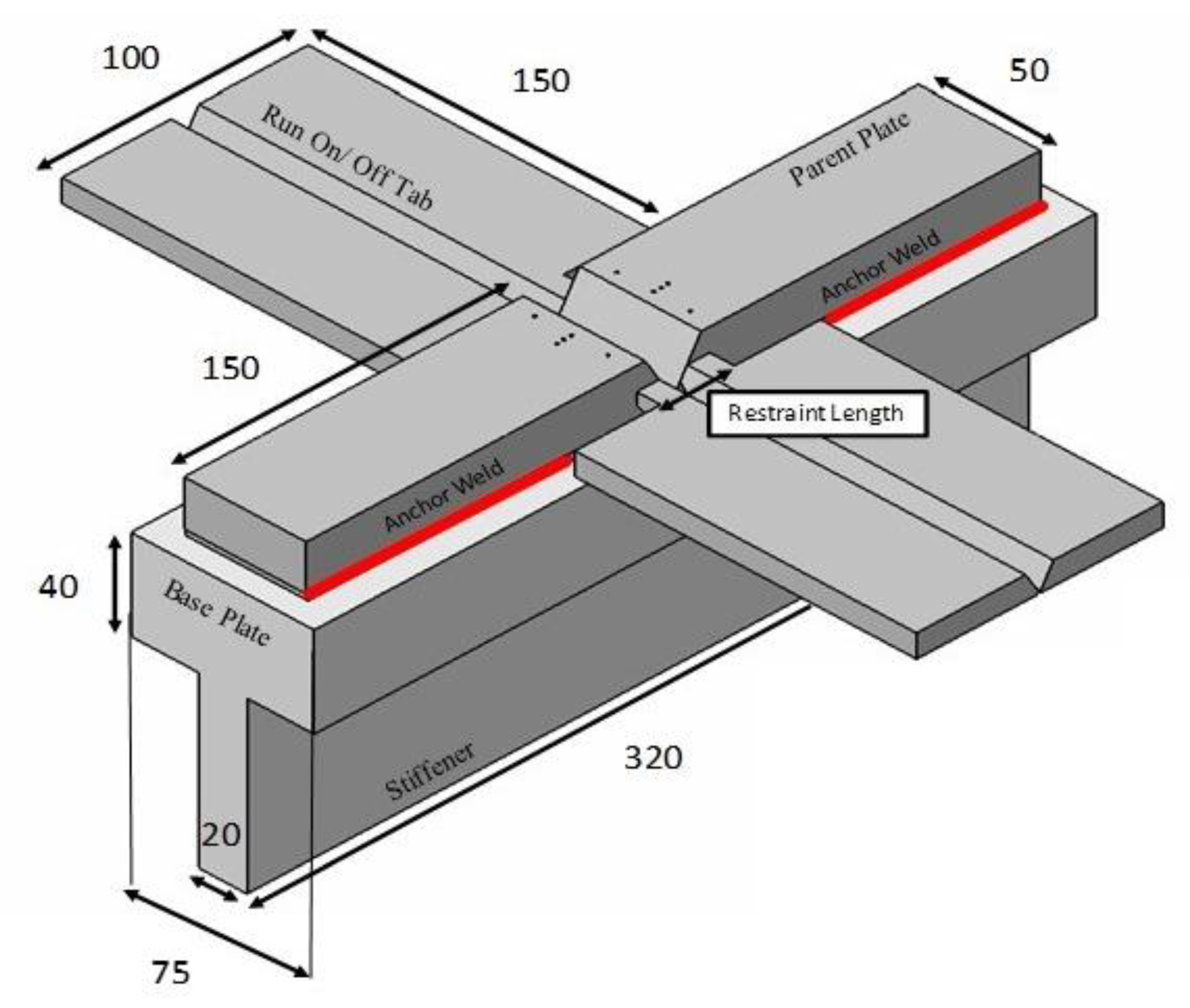
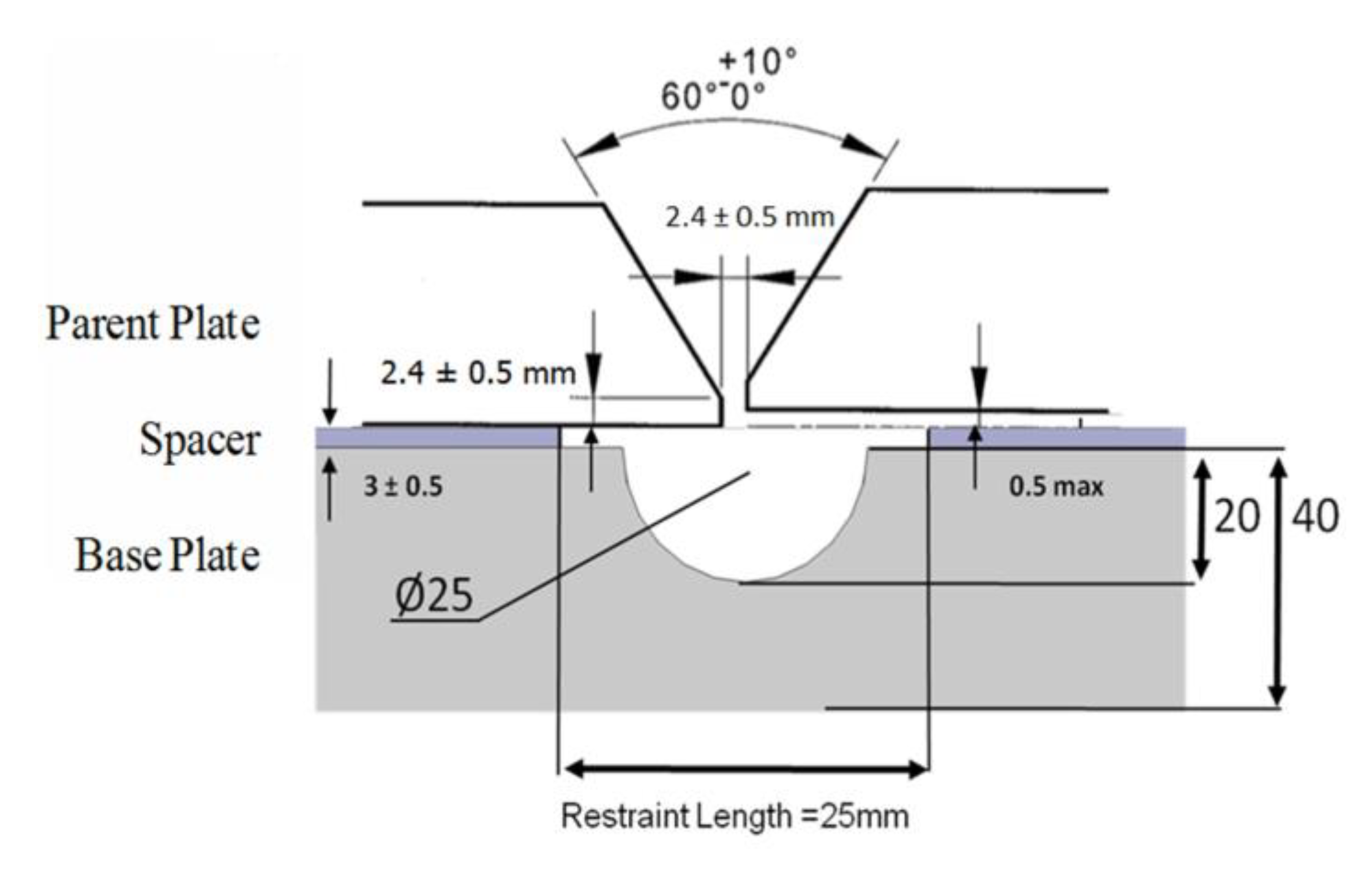
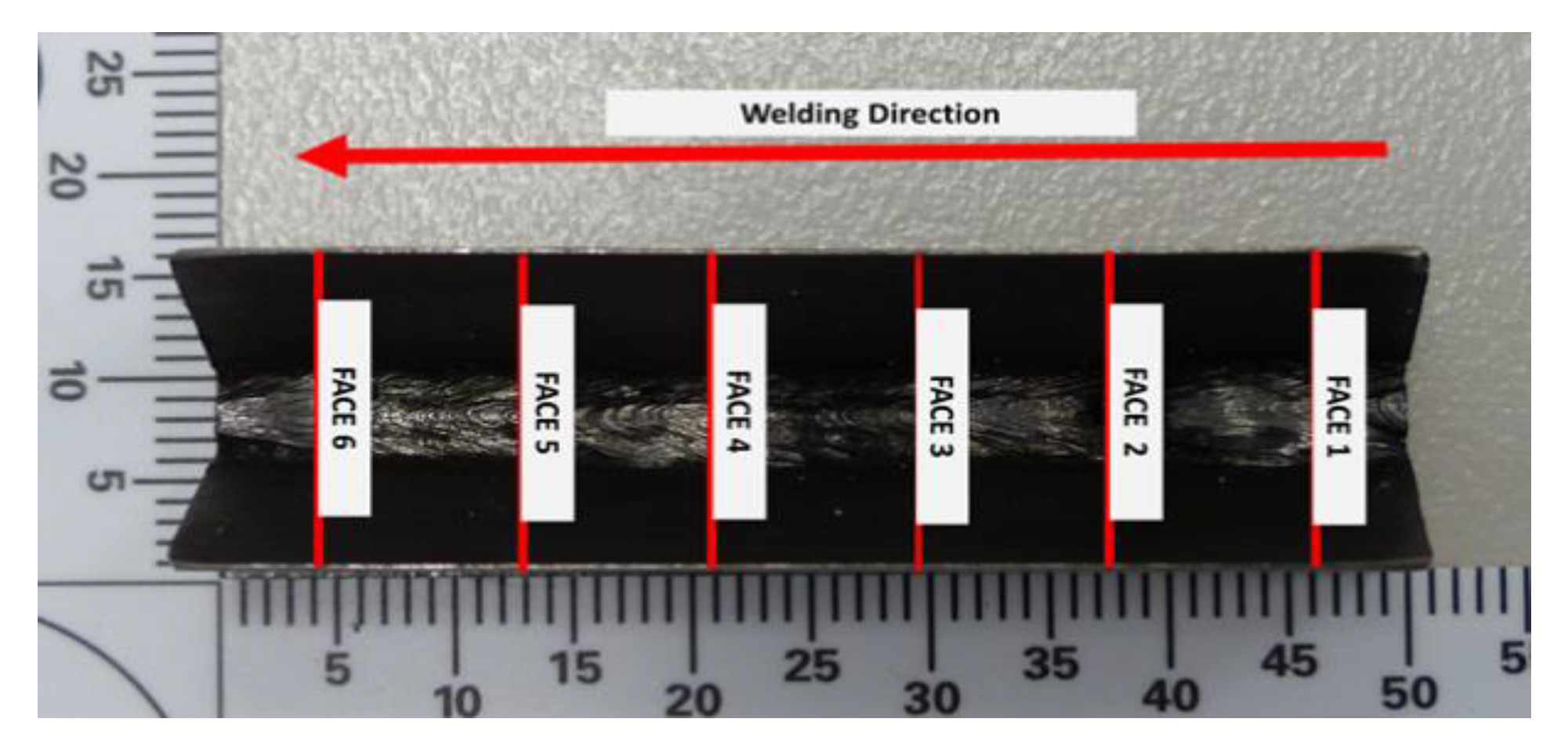

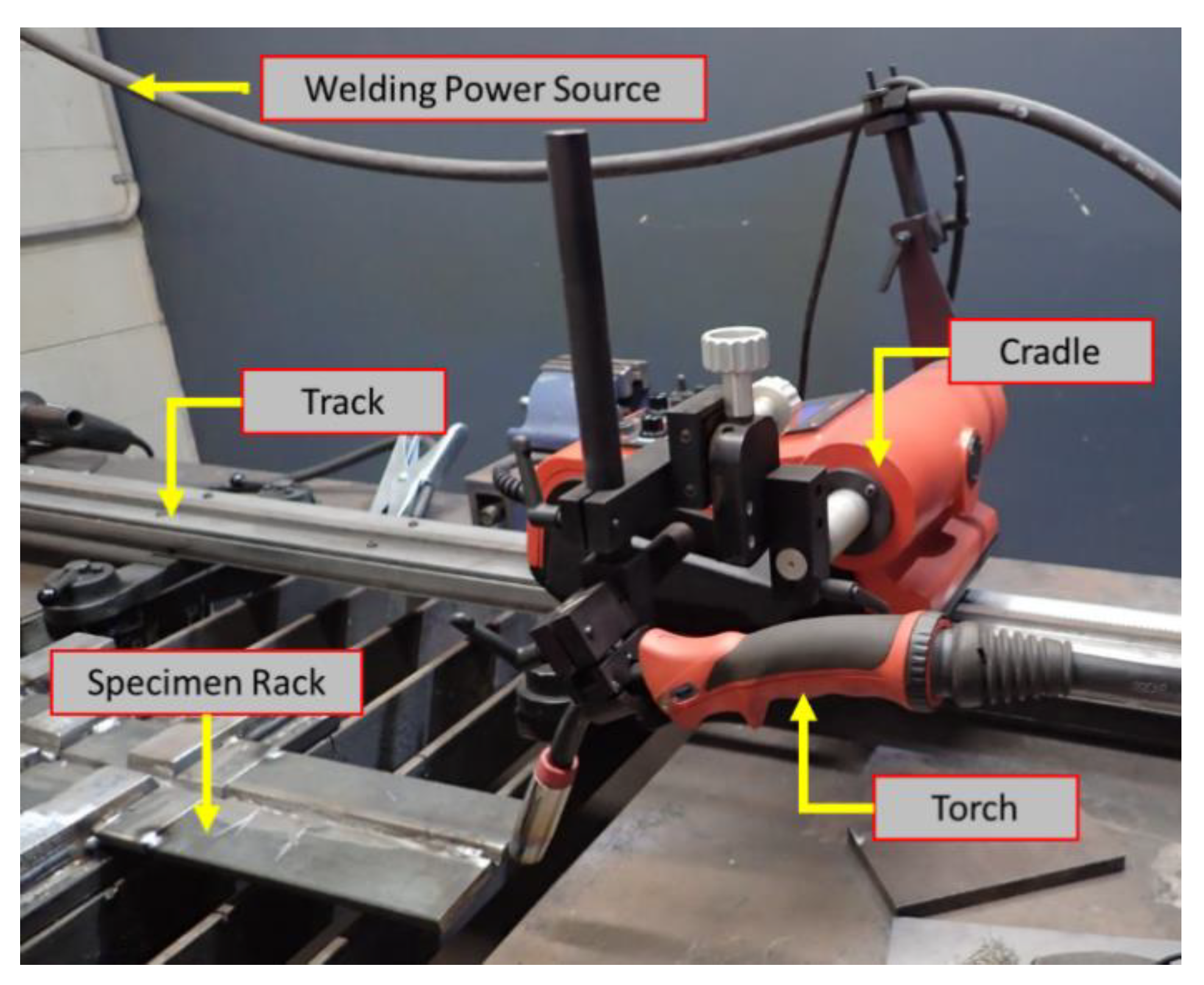
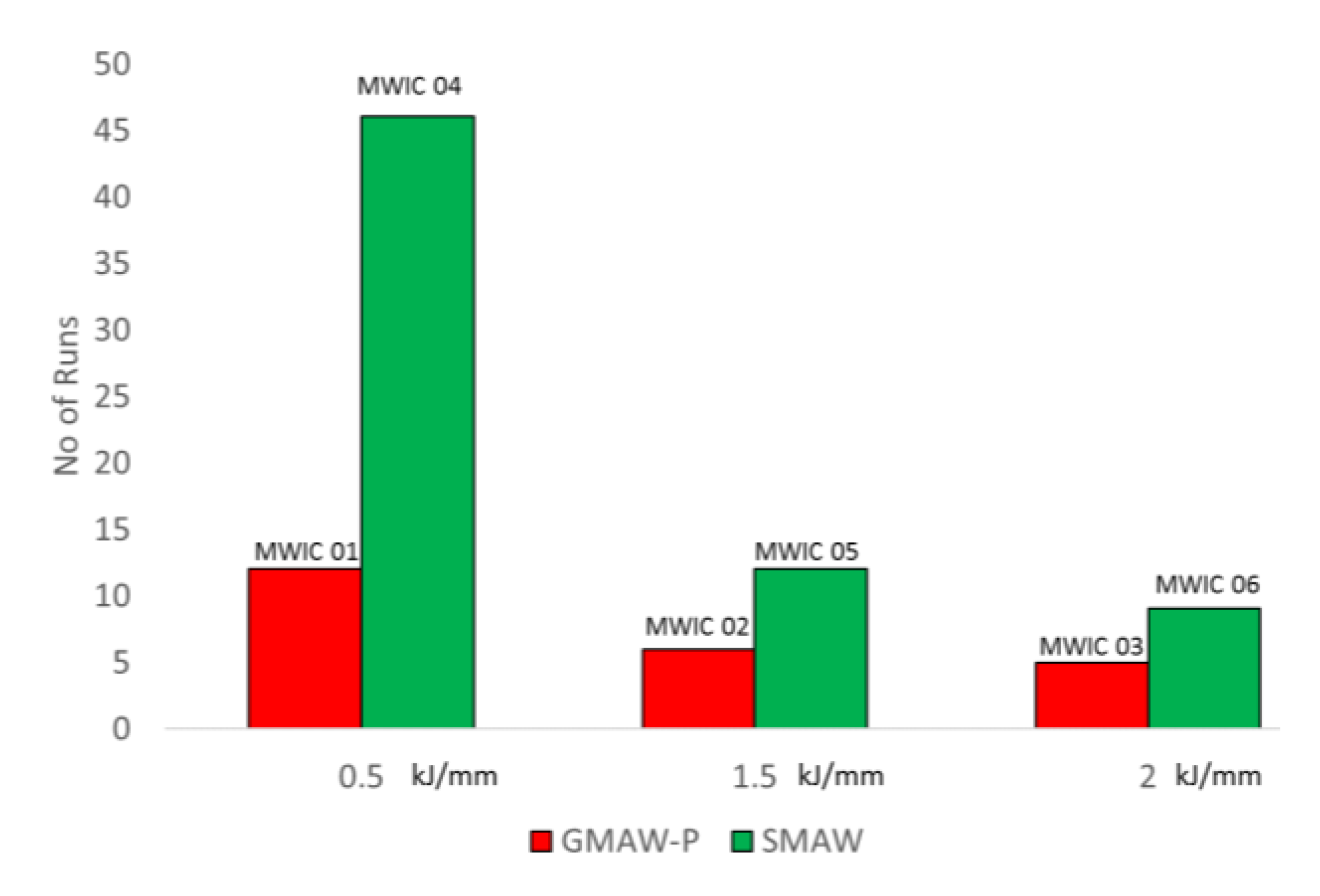
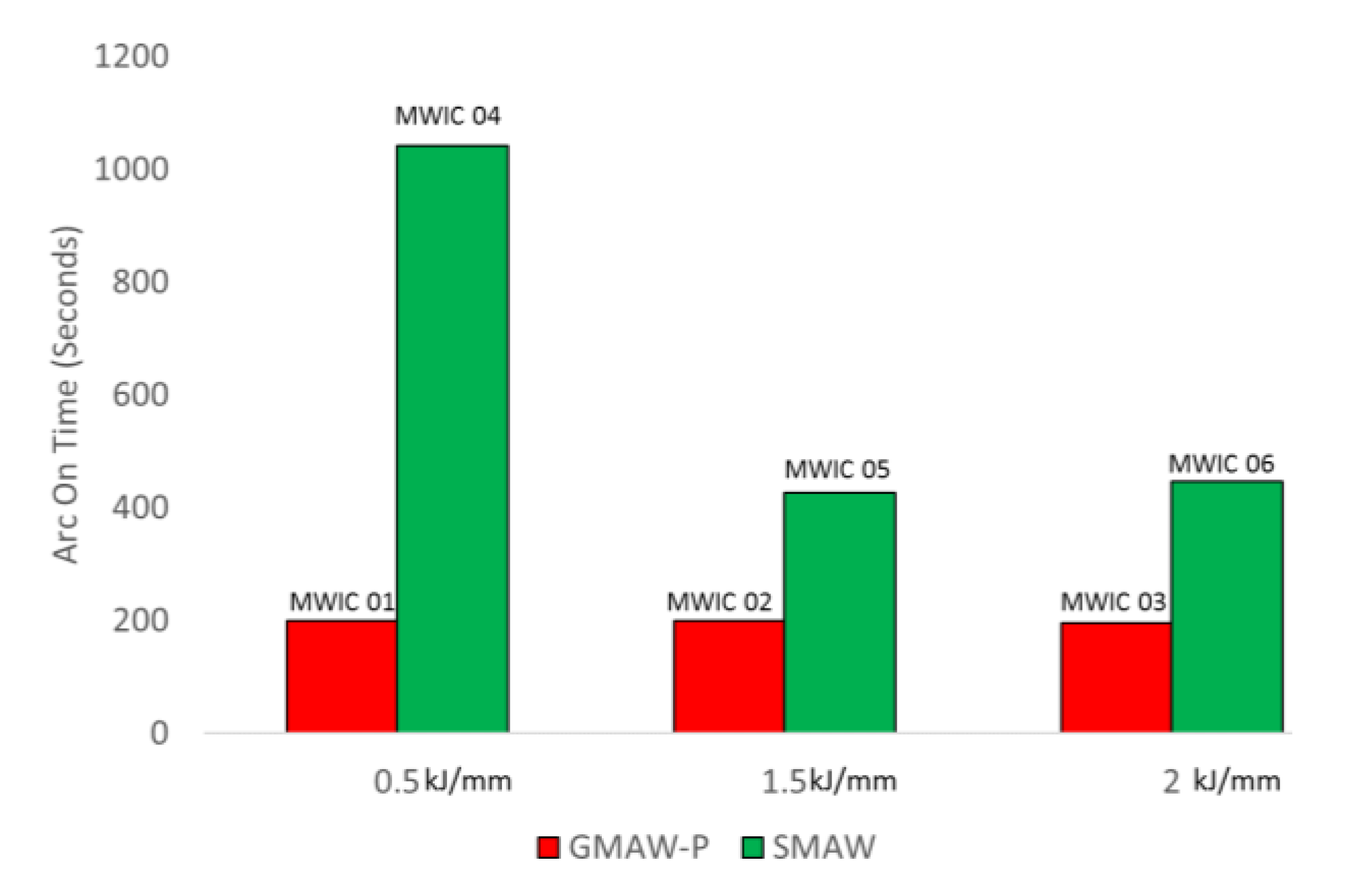
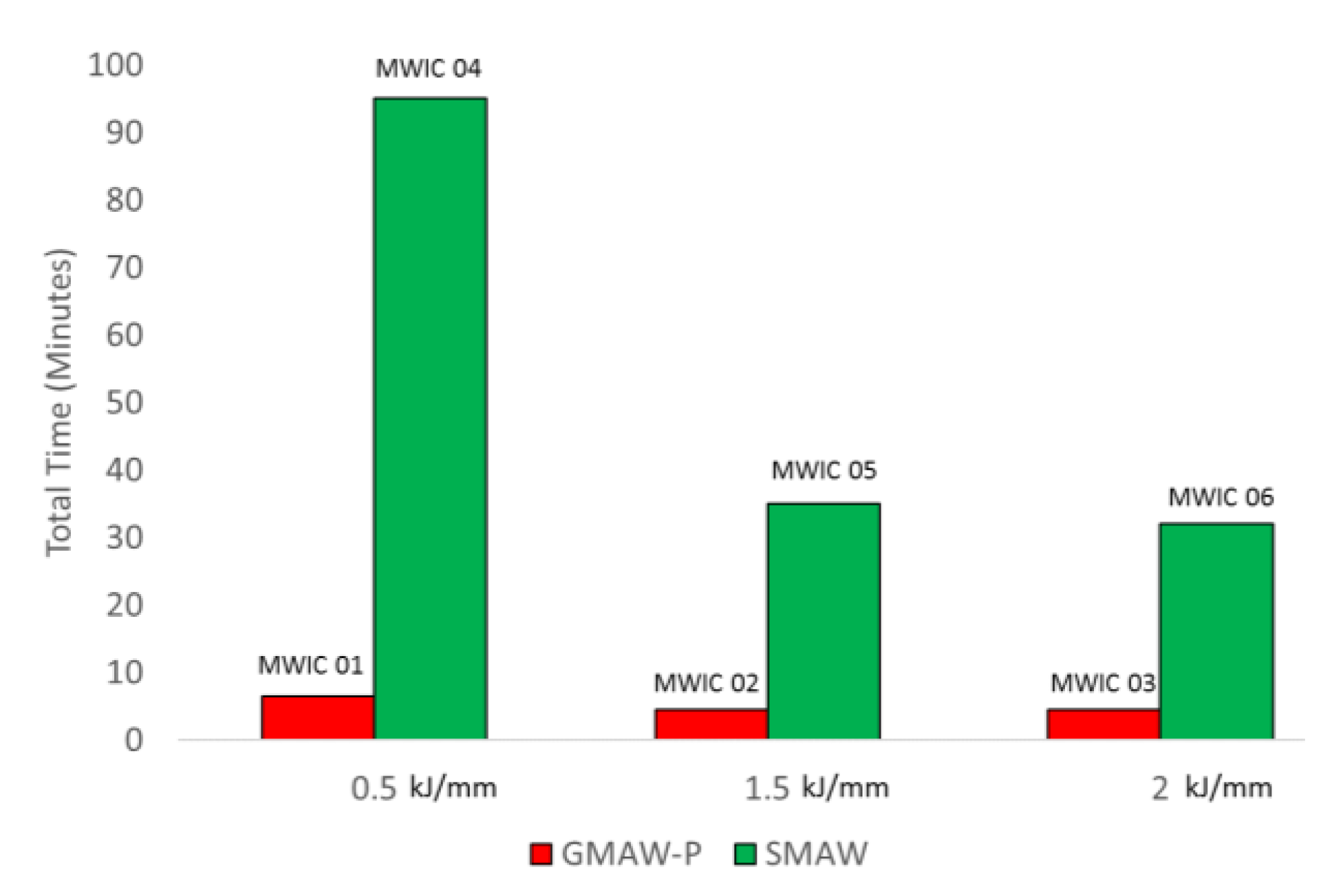
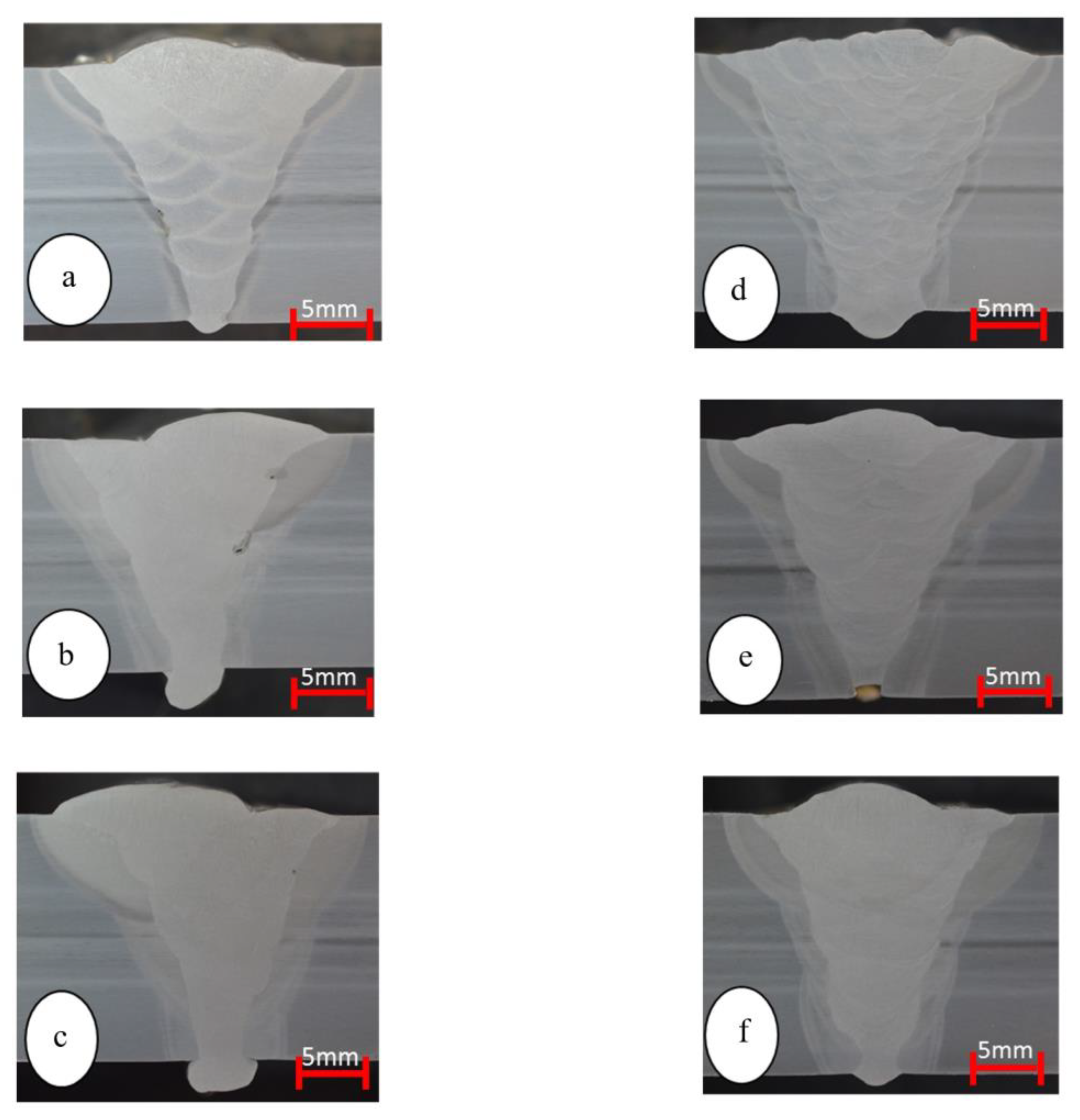
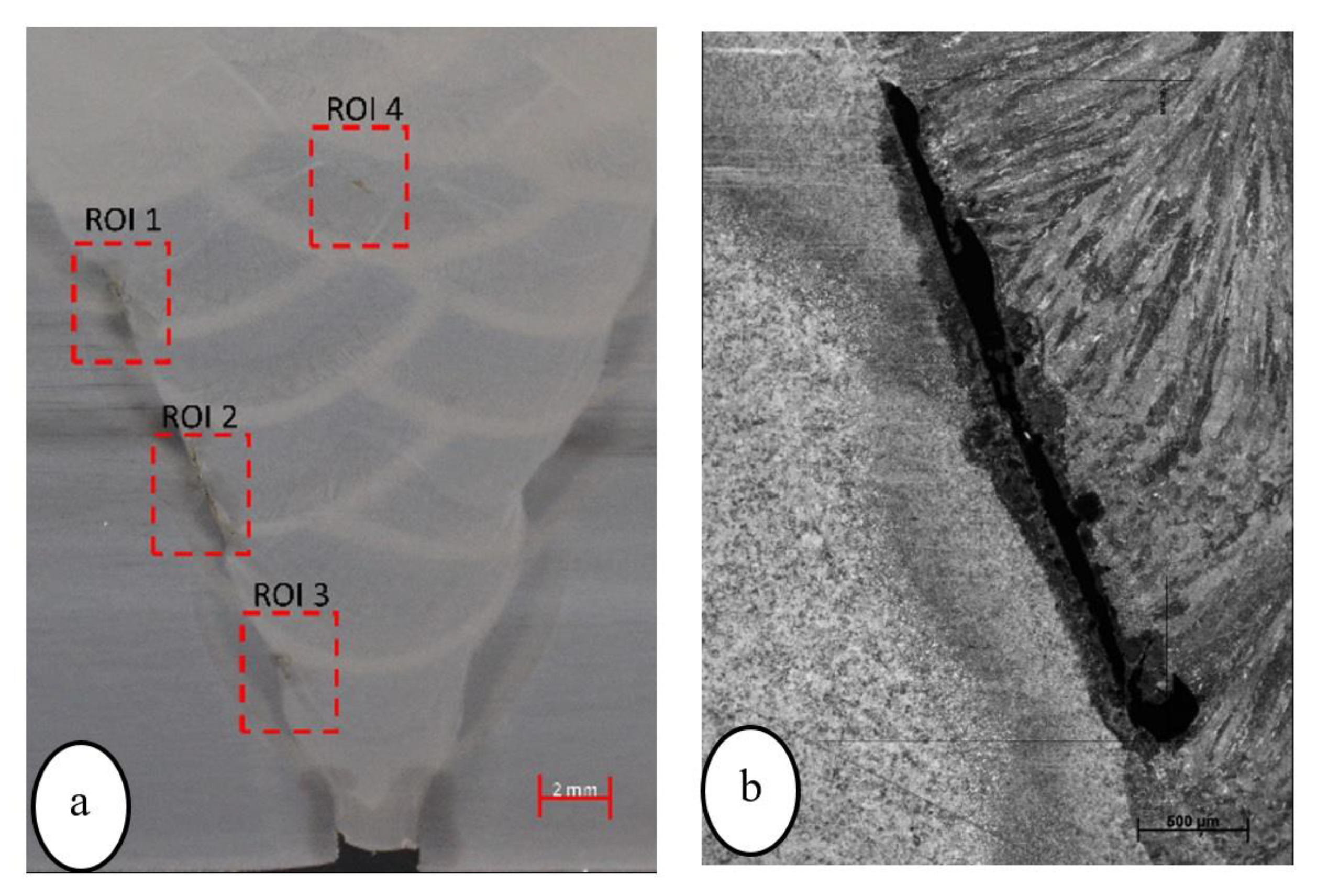
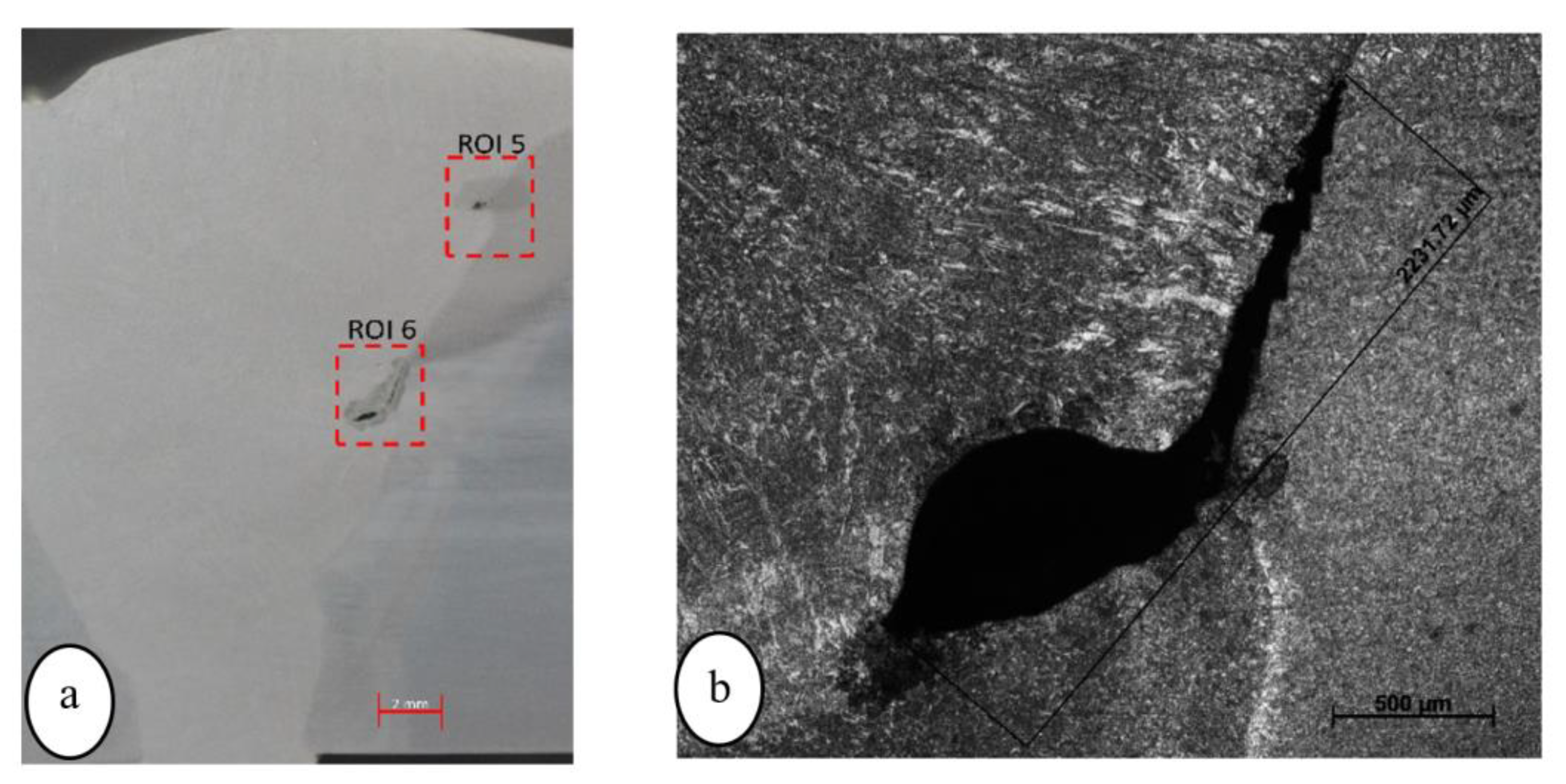
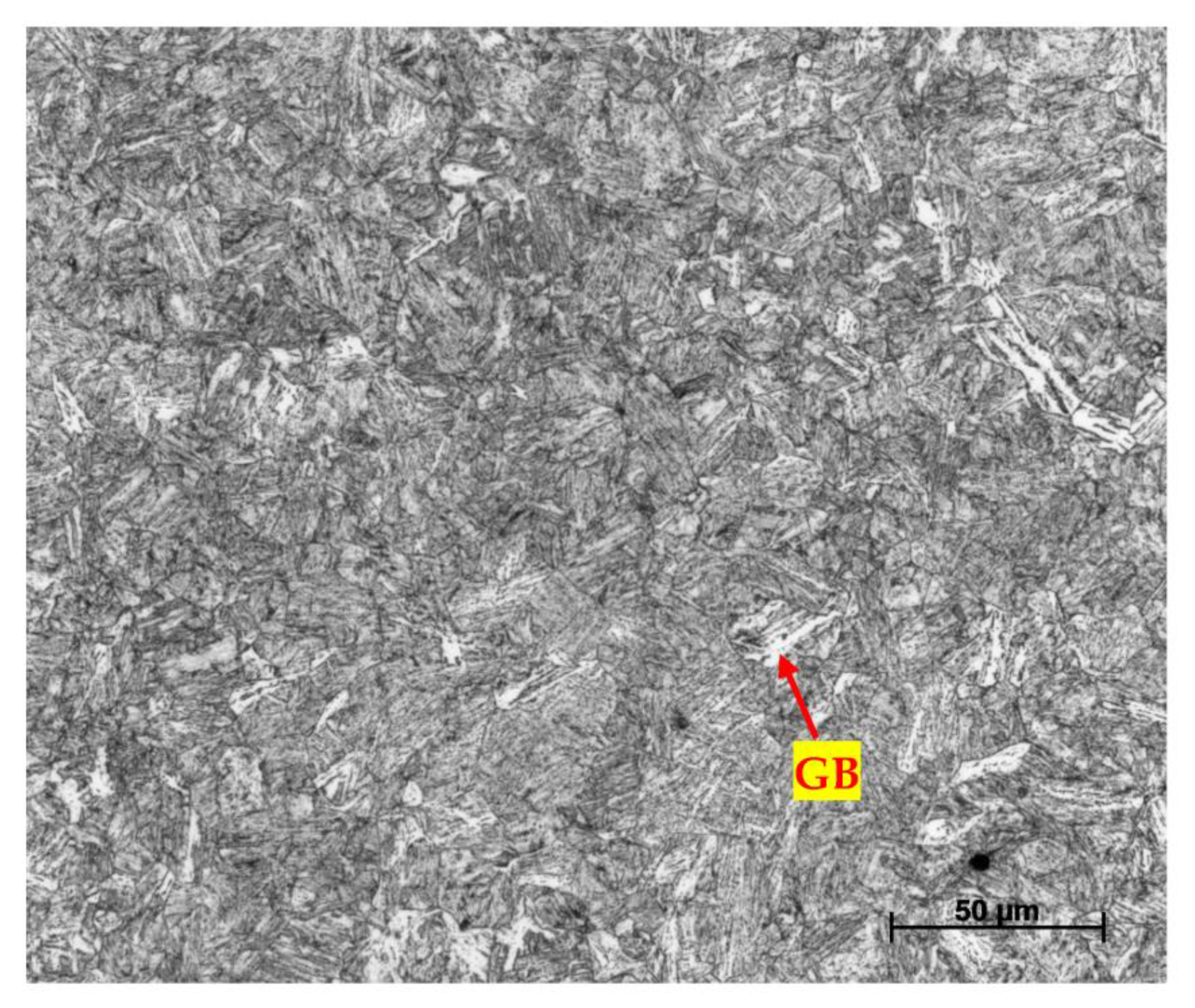
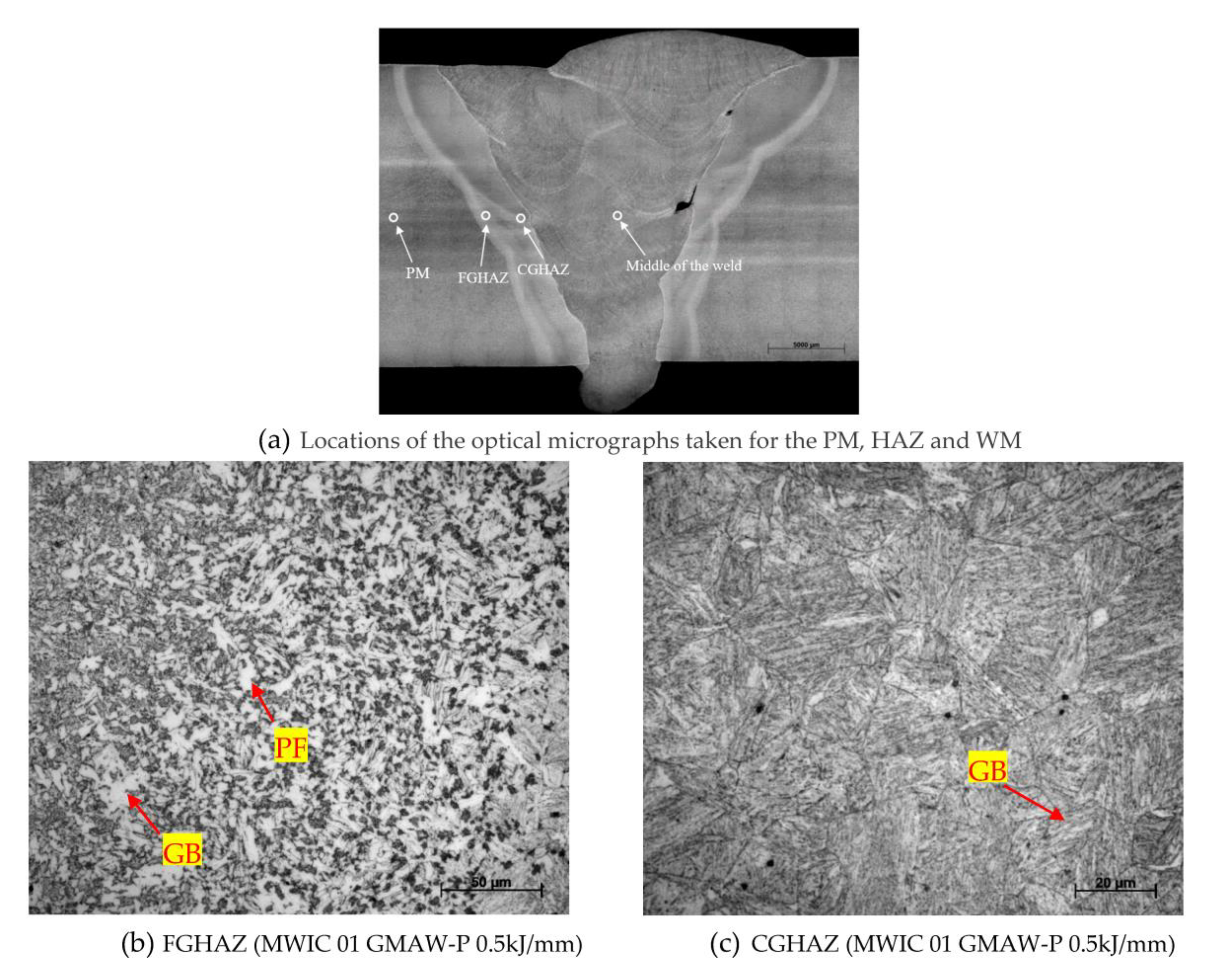


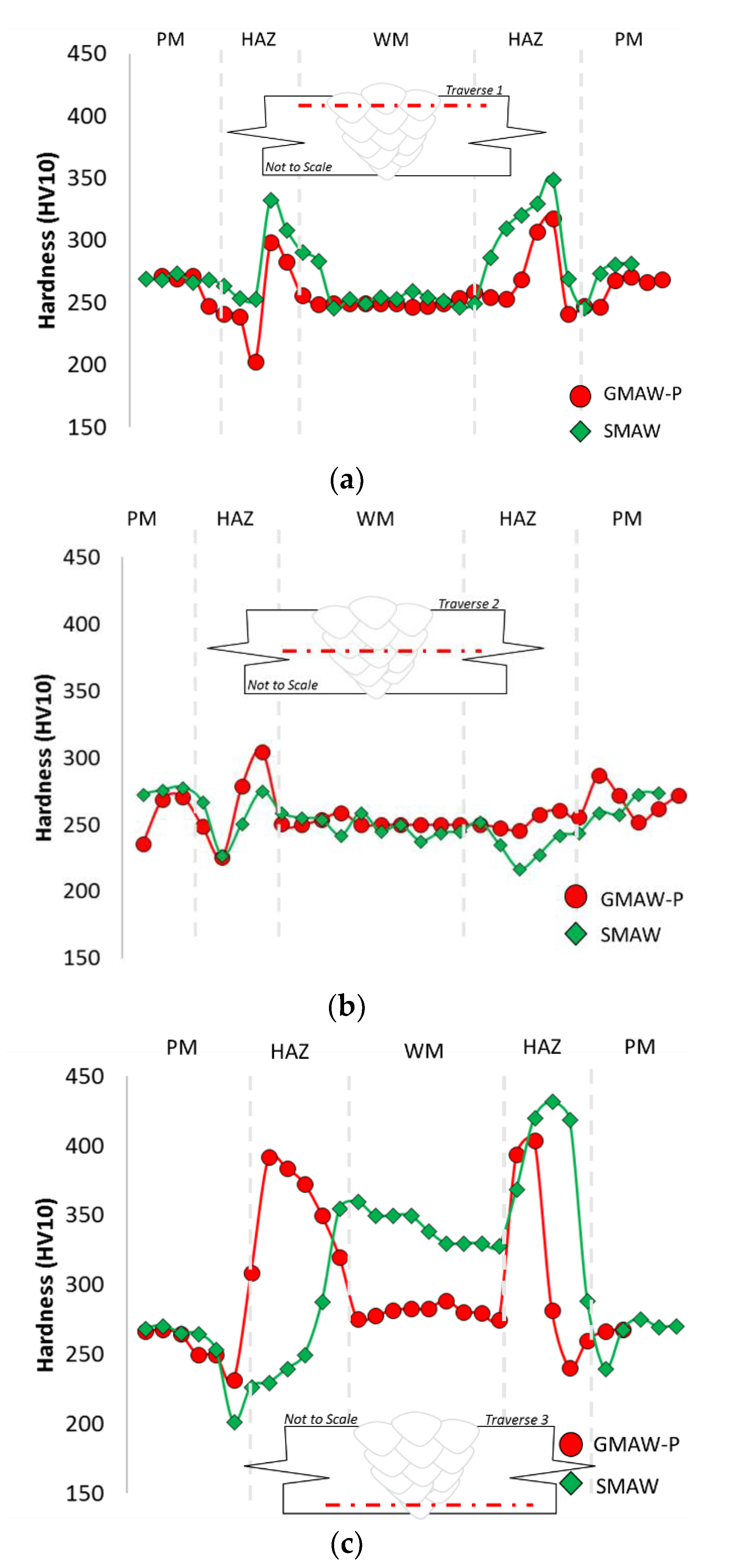
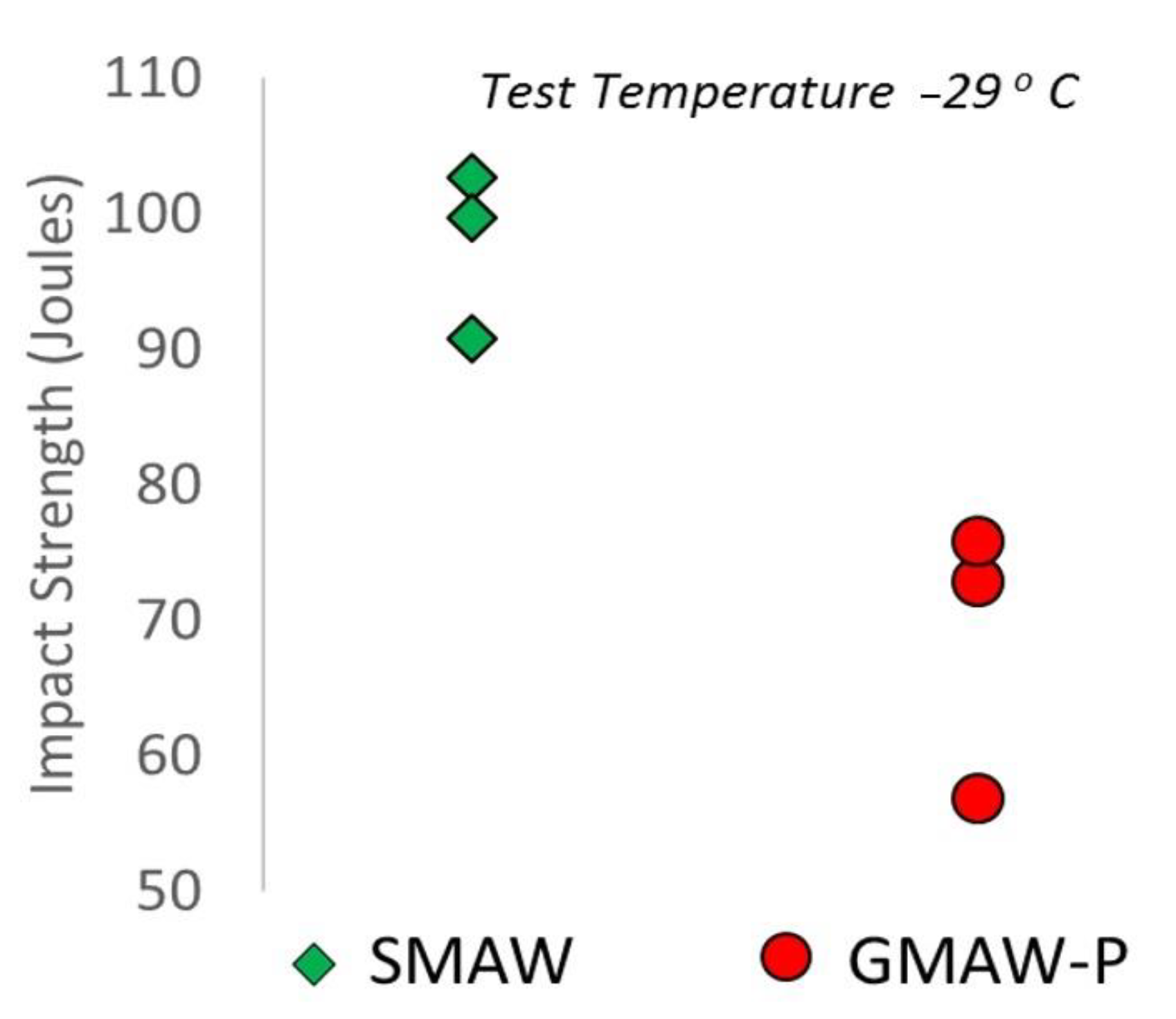
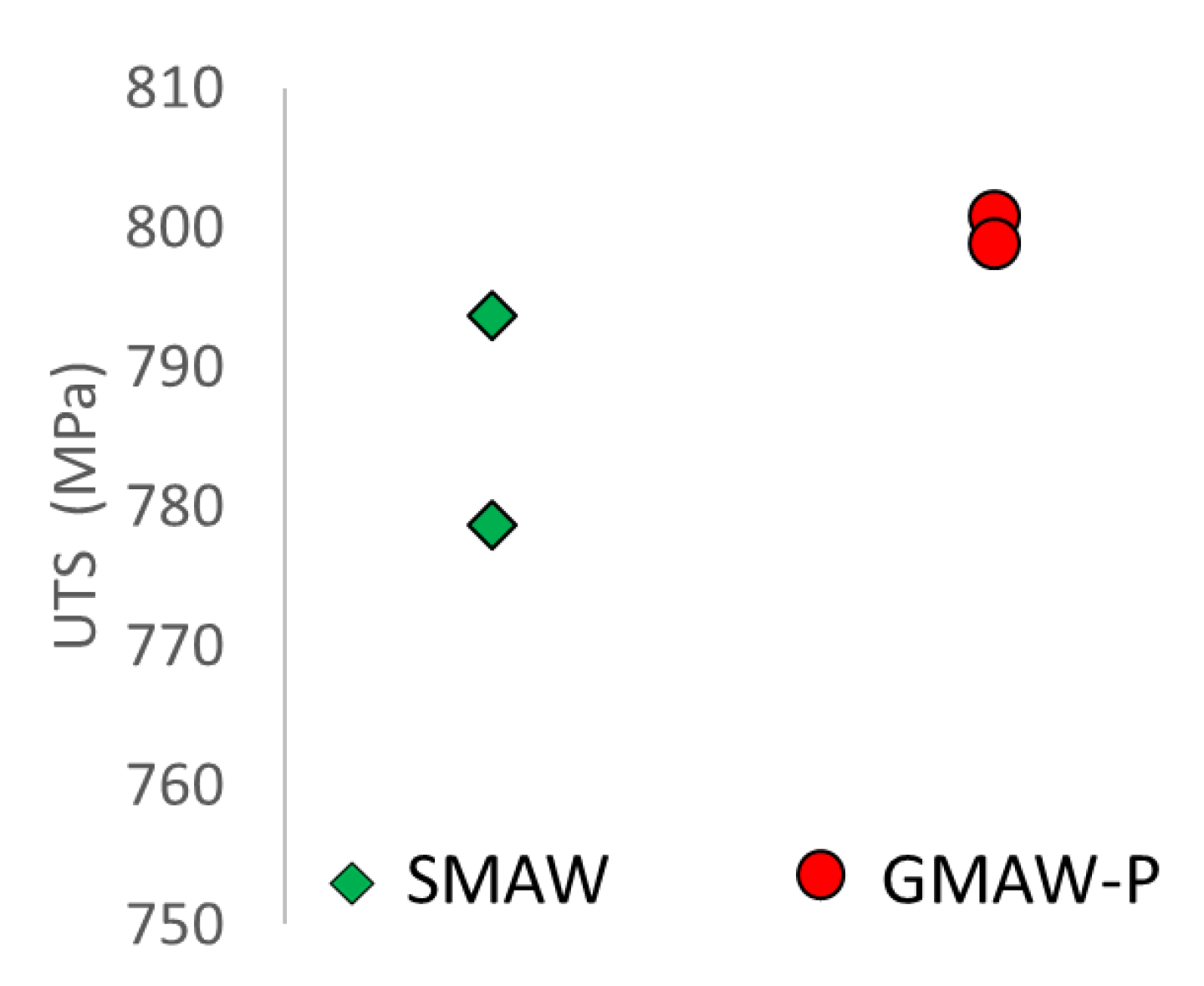
| Welding Specifications | Welding Parameters | ||
|---|---|---|---|
| Diameter of Wire | 1.2 mm | Current | 135–225 A |
| Direction | Flat (1G) | Travel Speed | 170–400 mm/min |
| Polarity | DC+ | Voltage | 21–30 V |
| Specification | ER 110S-G | Pre Heat Range | 25 °C |
| AWS Class | A5.28 | Heat Input Range | 0.48–2.19 kJ/mm |
| Shielding Gas | Ar 18% CO2 (15–20 L/min) | Deposition Mode | GMAW-P (ISO 857 (Process No. 13)) |
| Welding Specifications | Welding Parameters | ||
|---|---|---|---|
| Direction | Flat (1G) | Current | 130–180 A |
| Size of Electrode | 3.2 & 4.0 mm | Voltage | 21–25 V |
| AWS Class | A5.5 | Travel Speed | 80–290 mm/min |
| Specification | E11018M-H4 (moisture resistant low-hydrogen coated electrode) | Heat Input Range | 0.41–2.22 kJ/mm |
| Polarity | DC+ | Pre Heat Range | 25 °C |
| C | P | Cr | Si | S | Al | Ni | Mn | Mo | Cu | Ti | Sn | B | CE(IIW) |
|---|---|---|---|---|---|---|---|---|---|---|---|---|---|
| 0.17 | 0.018 | 0.2 | 0.21 | 0.004 | 0.035 | 0.017 | 1.37 | 0.2 | 0.026 | 0.019 | 0.002 | 0.0017 | 0.4812 |
| C | Si | Mn | Ni | Mo | Cr | V |
|---|---|---|---|---|---|---|
| 0.09 | 0.5 | 1.6 | 1.4 | 0.25 | 0.3 | 0.09 |
| C | Mn | P | Si | Mo | S | Ni | Cr | V |
|---|---|---|---|---|---|---|---|---|
| 0.06 | 1.5 | 0.015 | 0.4 | 0.4 | 0.01 | 2.2 | <0.15 | 0.08 |
Disclaimer/Publisher’s Note: The statements, opinions and data contained in all publications are solely those of the individual author(s) and contributor(s) and not of MDPI and/or the editor(s). MDPI and/or the editor(s) disclaim responsibility for any injury to people or property resulting from any ideas, methods, instructions or products referred to in the content. |
© 2023 by the authors. Licensee MDPI, Basel, Switzerland. This article is an open access article distributed under the terms and conditions of the Creative Commons Attribution (CC BY) license (https://creativecommons.org/licenses/by/4.0/).
Share and Cite
Alipooramirabad, H.; Cornish, N.; Kurji, R.; Roccisano, A.; Ghomashchi, R. Quenched and Tempered Steels Welded Structures: Modified Gas Metal Arc Welding-Pulse vs. Shielded Metal Arc Welding. Metals 2023, 13, 887. https://doi.org/10.3390/met13050887
Alipooramirabad H, Cornish N, Kurji R, Roccisano A, Ghomashchi R. Quenched and Tempered Steels Welded Structures: Modified Gas Metal Arc Welding-Pulse vs. Shielded Metal Arc Welding. Metals. 2023; 13(5):887. https://doi.org/10.3390/met13050887
Chicago/Turabian StyleAlipooramirabad, Houman, Neville Cornish, Rahim Kurji, Anthony Roccisano, and Reza Ghomashchi. 2023. "Quenched and Tempered Steels Welded Structures: Modified Gas Metal Arc Welding-Pulse vs. Shielded Metal Arc Welding" Metals 13, no. 5: 887. https://doi.org/10.3390/met13050887
APA StyleAlipooramirabad, H., Cornish, N., Kurji, R., Roccisano, A., & Ghomashchi, R. (2023). Quenched and Tempered Steels Welded Structures: Modified Gas Metal Arc Welding-Pulse vs. Shielded Metal Arc Welding. Metals, 13(5), 887. https://doi.org/10.3390/met13050887








